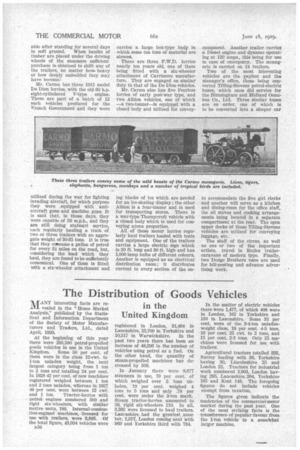The Distribution of Goods Vehicles
Page 134

If you've noticed an error in this article please click here to report it so we can fix it.
in the United Kingdom
MANY interesting facts are revealed in the "Home Market Analysis," published by the Statistical and Information Department of the Society of Motor Manufacturers and Traders, Ltd., dated April, 1929.
At the beginning of this year there were 295,590 petrol-propelled goods vehicles in use in the United Kingdom. Some 50 per cent. of them were in the class 12-cwt. to 1-ton unladen weight, the next largest category being from 1 ton to 2 tons and totalling 24 per cent. ln 1928 42 per cent. of new machines registered weighed between 1 ton and 2 tons unladen, whereas in 1927 49 per cent. were between 12 cwt.
and 1 ton. Tractor-lorries with petrol engines numbered 509 and rigid six-wheelers, with shnilar motive units, 186. Internal-combustion-engined machines, licensed for use with trailers, were 3,895. Of the total figure, 43,934 vehicles Were D56 registered in London, 31,494 in Lancashire, 25,700 in Yorkshire and 10,517 in Warwickshire. In the past two years there has been an increase of 48,206 in the number of vehicles using petrol as a fuel. On the other hand, the quantity of steam-propelled machines has decreased by 509.
In January there were 8,677 steamers in use, 79 per cent. of which weighed over 5 tons unladen, 19 per cent. weighed 4 tons to 5 tons and only .78 per cent. were under the 3-ton mark. Steam tractor-lorries amounted to 59, rigid six-wheelers 110. In all, 3,392 were licensed to haul trailers. Lancashire had the greatest num.ber, 1,577; London coming next with 969 and Yorkshire third with 784. In the matter of electric vehicles there were 1,477, of which 408 were in London, 162 in Yorkshire and 130 in Lancashire. Some 31 per cent, were of the 3-4-ton unladenweight class, 19 per cent. 4-5 tons, 16 per cent. 25 cwt. to 2 tons, and 15 per cent. 2-3 tons. Only 25 machines were licensed for use with trailers.
Agricultural tractors totalled 333, Surrey leading with 38, Yorkshire having 30, Lincolnshire 25 and London 22. Tractors for industrial work numbered 2,901, London having 295, Lancashire 264, Yorkshire 185 and Kent 148. The foregoing figures do not include vehicles exempt from taxation.
The figures given indicate the tendencies of the commercial-motor market during the past year. One of the most striking facts is the transference of popular favour from the 1-ton vehicle to a someiyhat larger machine.








































































































































































































